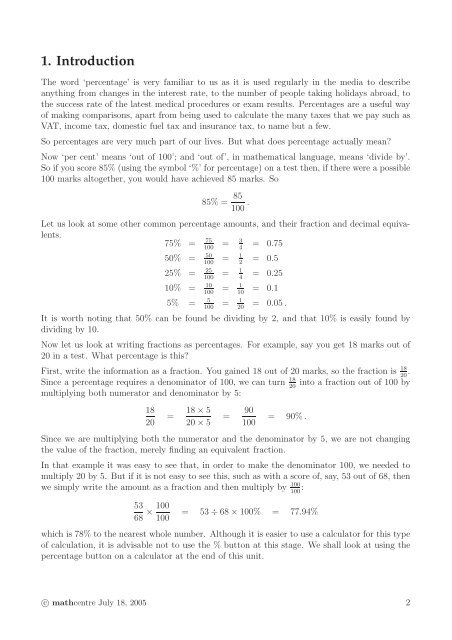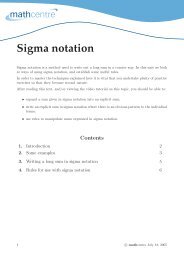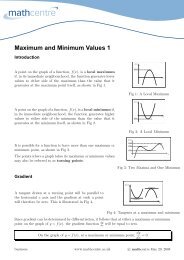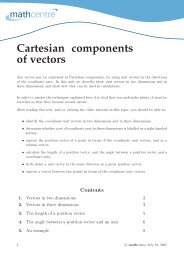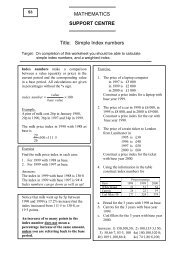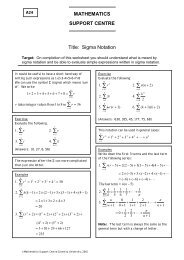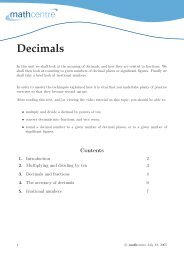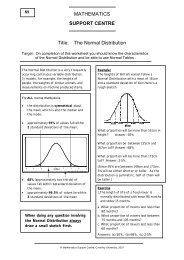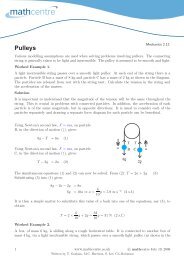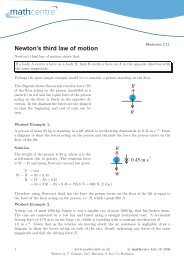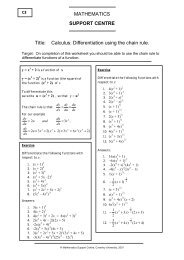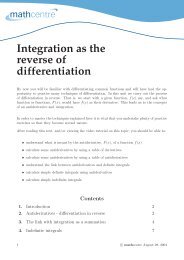Percentages
Percentages
Percentages
You also want an ePaper? Increase the reach of your titles
YUMPU automatically turns print PDFs into web optimized ePapers that Google loves.
1. Introduction<br />
The word ‘percentage’ is very familiar to us as it is used regularly in the media to describe<br />
anything from changes in the interest rate, to the number of people taking holidays abroad, to<br />
the success rate of the latest medical procedures or exam results. <strong>Percentages</strong> are a useful way<br />
of making comparisons, apart from being used to calculate the many taxes that we pay such as<br />
VAT, income tax, domestic fuel tax and insurance tax, to name but a few.<br />
So percentages are very much part of our lives. But what does percentage actually mean?<br />
Now ‘per cent’ means ‘out of 100’; and ‘out of’, in mathematical language, means ‘divide by’.<br />
So if you score 85% (using the symbol ‘%’ for percentage) on a test then, if there were a possible<br />
100 marks altogether, you would have achieved 85 marks. So<br />
85% = 85<br />
100 .<br />
Let us look at some other common percentage amounts, and their fraction and decimal equivalents.<br />
75% = 75<br />
100<br />
= 3 4<br />
= 0.75<br />
50% = 50<br />
100<br />
= 1 2<br />
= 0.5<br />
25% = 25<br />
100<br />
= 1 4<br />
= 0.25<br />
10% = 10 = 1<br />
100 10<br />
= 0.1<br />
5% = 5 = 1<br />
100 20<br />
= 0.05 .<br />
It is worth noting that 50% can be found be dividing by 2, and that 10% is easily found by<br />
dividing by 10.<br />
Now let us look at writing fractions as percentages. For example, say you get 18 marks out of<br />
20 in a test. What percentage is this?<br />
First, write the information as a fraction. You gained 18 out of 20 marks, so the fraction is 18<br />
Since a percentage requires a denominator of 100, we can turn 18 into a fraction out of 100 by<br />
20<br />
multiplying both numerator and denominator by 5:<br />
18<br />
20<br />
= 18 × 5<br />
20 × 5<br />
=<br />
90<br />
100<br />
= 90%.<br />
Since we are multiplying both the numerator and the denominator by 5, we are not changing<br />
the value of the fraction, merely finding an equivalent fraction.<br />
In that example it was easy to see that, in order to make the denominator 100, we needed to<br />
multiply 20 by 5. But if it is not easy to see this, such as with a score of, say, 53 out of 68, then<br />
we simply write the amount as a fraction and then multiply by 100<br />
100 :<br />
53<br />
68 × 100<br />
100<br />
= 53 ÷ 68 × 100% = 77.94%<br />
which is 78% to the nearest whole number. Although it is easier to use a calculator for this type<br />
of calculation, it is advisable not to use the % button at this stage. We shall look at using the<br />
percentage button on a calculator at the end of this unit.<br />
20 .<br />
c○ mathcentre July 18, 2005 2


